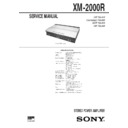Sony XM-2000R Service Manual ▷ View online
– 9 –
SECTION 4
ELECTRICAL ADJUSTMENTS
IDLING ADJUSTMENT (without signal input)
Note:
The idling adjustment should be executed on the L-CH and R-CH
of the POWER AMP board respectively.
of the POWER AMP board respectively.
Connection:
Procedure:
1. Connect the digital voltmeter to TP1 and TP2 on the POWER
1. Connect the digital voltmeter to TP1 and TP2 on the POWER
AMP board.
2. Turn fully the VR901 counterclockwise. (*1)
3. Turn on the power.
4. Turn the VR901 (*2) so that a reading on the digital voltmeter
3. Turn on the power.
4. Turn the VR901 (*2) so that a reading on the digital voltmeter
is in a range of 1mV to 3mV in the center of 2mV. (*3)
5. In the same manner, adjust another POWER AMP board.
*1: This prevents over current from flowing. If over current flows, the
protector works to disable the amplifier.
*2: The idling current increases when VR901 is turned clockwise, or
decreases by counterclockwise turn.
*3: The voltage will fluctuate sensitively, thus requiring careful
adjustment.
Adjustment Location: See page 10 .
Digital voltmeter
TP1
TP2
TP2
POWER AMP board (L-CH or R-CH)
+
–
–
PROTECTOR CHECK
Note 1:
Check it without canceling the protector.
Note 2:
The protector check should be executed on the L-CH and R-CH
of the POWER AMP board respectively.
of the POWER AMP board respectively.
1.
Offset Protector Check
Procedure:
1. Turn on the power, and short the SPEAKER OUT terminal
1. Turn on the power, and short the SPEAKER OUT terminal
(CN812 or CN813) and +12V terminal (CN814) on the
POWER AMP board.
POWER AMP board.
2. The protector will work, then confirm that the OFFSET LED
(D851) color changes lighting green to flashing red and the
output is turned off.
output is turned off.
3. Open the SPEAKER OUT terminal and +12V terminal.
4. Confirm that the protector is not reset.
5. Turn off the power once, and turn it on again, then confirm
4. Confirm that the protector is not reset.
5. Turn off the power once, and turn it on again, then confirm
that the protector does not work.
Checking Location: See page 10 .
2.
Over Current Protector Check
Procedure:
1. Turn on the power, and short TP2 and TP3 on the POWER
1. Turn on the power, and short TP2 and TP3 on the POWER
AMP board.
2. The protector will work, then confirm that the OVER CUR-
RENT LED (D852) color changes lighting green to flashing
red and the output is turned off.
red and the output is turned off.
3. Open the TP2 and TP3.
4. Confirm that the protector is not reset.
5. Turn off the power once, and turn it on again, then confirm
4. Confirm that the protector is not reset.
5. Turn off the power once, and turn it on again, then confirm
that the protector does not work.
Checking Location: See page 10 .
3.
Thermal Protector Check
Procedure:
1. Turn on the power, and short TP4 and TP5 on the POWER
1. Turn on the power, and short TP4 and TP5 on the POWER
AMP board.
2. The protector will work, then confirm that the THERMAL LED
(D855) color changes lighting green to flashing red, the fun
motor (M810 or M811) rotates, and the output is turned off.
motor (M810 or M811) rotates, and the output is turned off.
3. Open the TP4 and TP5.
4. Confirm that the protector is reset.
4. Confirm that the protector is reset.
Checking Location: See page 10 .
– 10 –
Adjustment Location and Checking Location :
– POWER AMP Board (L-CH or R-CH) (Component Side) –
+
+
+
+
TP3
TP2
C919
TP1
C920
C917
C916
TP5
TP4
VR901 Idling Adjustment
– LED Board (Conductor Side) –
D854
D853
D855
THERMAL
D851
OFFSET
D852
OVER CURRENT
CNB807
– FRONT VIEW –
CN814 +12V (L/R) terminals
CN813
LEFT
SPEAKER OUT
terminals
CN812
RIGHT
RIGHT
– 11 –
SECTION 5
DIAGRAMS
• Circuit Boards Location
POWER AMP board (L-ch)
PRE AMP board
LED board
POWER AMP board (R-ch)
PROTECT board
– 12 –
• Circuit Boards Location
5-1. NOTE FOR PRINTED WIRING BOARDS AND SCHEMATIC DIAGRAMS
Note on Printed Wiring Board:
•
•
X
: parts extracted from the component side.
•
Y
: parts extracted from the conductor side.
•
b
: Pattern from the side which enables seeing.
(The other layers' patterns are not indicated.)
Note on Schematic Diagram:
• All capacitors are in µF unless otherwise noted. pF: µµF
50 WV or less are not indicated except for electrolytics
and tantalums.
and tantalums.
• All resistors are in
Ω
and
1
/
4
W or less unless otherwise
specified.
•
2
: nonflammable resistor.
•
C
: panel designation.
•
U
: B+ Line.
•
V
: B– Line.
•
H
: adjustment for repair.
• Power voltage is dc 14.4V and fed with regulated dc power
supply from +12V terminal (CN814) and REMOTE termi-
nal (CNJ803).
nal (CNJ803).
• Voltages and waveforms are dc with respect to ground
under no-signal conditions.
• Voltages are taken with a VOM (Input impedance 10 M
Ω
).
Voltage variations may be noted due to normal produc-
tion tolerances.
tion tolerances.
• Waveforms are taken with a oscilloscope.
Voltage variations may be noted due to normal produc-
tion tolerances.
tion tolerances.
• Circled numbers refer to waveforms.
• Signal path.
• Signal path.
F
: AUDIO
Caution:
Pattern face side:
Pattern face side:
Parts on the pattern face side seen from
(Conductor Side)
the pattern face are indicated.
Parts face side:
Parts on the parts face side seen from
(Component Side) the parts face are indicated.
Click on the first or last page to see other XM-2000R service manuals if exist.

